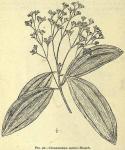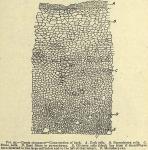168. Cinnamomum cassia.—Cassia bark.
 168. CINNAMOMUM CASSIA.—CASSIA BARK. The bark of the shoots of one or more undetermined species of Cinnamo'mum grown in China (Chinese cinnamon). Off. U.S.P. 1890. Cassia cinnamon is in tubes or curved pieces, of a darker yellowish-brown color than preceding, nearly deprived of the corky layer; these tubes are usually simple, rarely double, 1 mm. (1/25 in.) or more thick, and break with a rather short fracture; odor and taste similar to, but somewhat less delicate than, that of Ceylon cinnamon.
168. CINNAMOMUM CASSIA.—CASSIA BARK. The bark of the shoots of one or more undetermined species of Cinnamo'mum grown in China (Chinese cinnamon). Off. U.S.P. 1890. Cassia cinnamon is in tubes or curved pieces, of a darker yellowish-brown color than preceding, nearly deprived of the corky layer; these tubes are usually simple, rarely double, 1 mm. (1/25 in.) or more thick, and break with a rather short fracture; odor and taste similar to, but somewhat less delicate than, that of Ceylon cinnamon.
 Constituents the same, the volatile oil being officially recognized as from this source. This variety has been superseded by Saigon cinnamon in the official preparations containing cinnamon.
Constituents the same, the volatile oil being officially recognized as from this source. This variety has been superseded by Saigon cinnamon in the official preparations containing cinnamon.
168a. OLEUM CASSIAE.—OIL OF CINNAMON. Contains at least 80 per cent. of cinnamic aldehyde. Both the Ceylon oil and that derived from Cassia, and other cinnamon barks are found in commerce, and they are essentially the same. The oil of Ceylon cinnamon has a more delicate odor and flavor. All of the various oils of cinnamon become darker and thicker by age and exposure to the air; they have the characteristic odor of cinnamon, a sweetish, spicy, and burning taste.
CONSTITUENTS.—Oil Of cinnamon consists chiefly of cinnamic aldehyde, with small quantities of hydrocarbon; when the oil is exposed to the air for a time, the cinnamic aldehyde is oxidized into cinnamic acid, two resins, and water, the oil becoming thicker and darker, and frequently separating out a few crystals of the cinnamic acid.
- OFFICIAL PREPARATIONS.
- Aqua Cinnamomi (0.2 per cent.), Dose: ½ to 1 fl. oz. (15 to 30 Gm.).
- Spiritus Cinnamomi (10 per cent.), Dose: 10 to 20 drops (0.6 to 1.3 mils).

